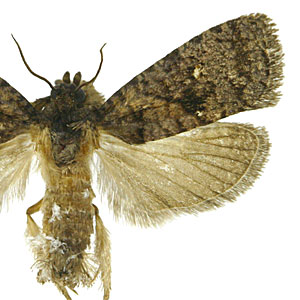Overview

The genus Cryptaspasma is pan-tropical and comprised of 34 described species. It has been recorded from Central America, South America, southern North America, Africa, Madagascar, Australia, New Zealand, New Caledonia, the Orient, and the eastern Palearctic. The genus has traditionally been considered the sole representative of the tribe Microcorsini; however, the Australian genus Collogenes was recently transferred to the Microcorsini by Horak (2006). Microcorsini are hypothesized to be the most basal group in Olethreutinae. The genus is currently divided into seven subgenera based on geographic distribution and structures of the male genitalia; Aarvik (2005) provided a key to the subgenera.
Adults are dark brown with subdued patterns that are relatively uniform across the entire genus. Males have an array of various sex scales on the legs, hindwing, and end of the abdomen; the presence and form of the sex scales is sometimes helpful in separating species. Male and female genitalia are also uniform within most subgenera, making species recognition difficult. Several undescribed species are present in Central America, South America, and Australasia.
The two species are treated here feed on avocado and other Lauraceae. Cryptaspasma bipenicilla is a native of the Caribbean, Central America, and the southeastern U.S.; it has not been reported causing damage to commercially grown avocado. Cryptaspasma perseana is a native of Central America that is a pest of avocado in Mexico and Guatemala. The orange to pink larvae tunnel into the hard seed, damaging the pulp and potentially inducing early fruit drop.
Target species
Cryptaspasma perseana
Non-target species Cryptaspasma bipenicilla
References

Aarvik, L. (2005) Revision of African Cryptaspasma Walsingham, 1900 (Lepidoptera: Tortricidae). Norwegian Journal of Entomology. 51: 193-201.
Brown, J. W. and R. L. Brown. 2004. A new species of Cryptaspasma Walsingham (Lepidoptera: Tortricidae: Olethreutinae) from Central America, the Caribbean, and southeastern United States, with a catalogue of the world fauna of Microcorsini. Proceedings of the Entomological Society of Washington. 106: 288-297.
Diakonoff, A. 1959. Revision of Cryptaspasma Walsingham 1900 (Lepidoptera, Tortricidae). Zoologische Verhandelingen (Leiden). 43: 1-60.
Gilligan, T. M., J. W. Brown and M. S. Hoddle. 2011. A new avocado pest in Central America (Lepidoptera: Tortricidae) with a key to Lepidoptera larvae threatening avocados in California. Zootaxa. 3137: 31-45.
Hoddle, M. S. and C. D. Hoddle. 2008. Lepidoptera and associated parasitoids attacking Hass and non-Hass avocadoes in Guatemala. Journal of Economic Entomology. 101: 1310-1316.Horak, M. 2006. Olethreutine moths of Australia (Lepidoptera: Tortricidae). Monographs on Australian Lepidoptera, Vol. 10. 522 pp.

